[Broadway Ad Network]
[Broadway Ad Network]

TICKET / INFO
- StudentRush
- New York Show Tickets
- Givenik.com
- Telecharge.com
- Ticketmaster.com
- Group Sales Box Office
- Frugal TheaterGoer
- Broadway for Broke People
- Playbill's Rush/Lottery/SR
- Seating Charts
COMMUNITY
NEWS
- Back Stage
- Bloomberg
- Broadway.com
- BroadwayWorld
- Entertainment Weekly
- NYTheatre.com
- New York Magazine
- The New York Daily News
- The New York Post
- The New York Times
- The New Yorker
- Newsday
- NiteLife Exchange
- Playbill
- Show Business Weekly
- The Star-Ledger
- Talkin'Broadway
- TheaterMania.com
- Time Out New York
- American Theatre Magazine
- Theatre Development Fund (TDF)
- Best of Off-Broadway
- The Village Voice
- Variety
- The Wall Street Journal
- Journal News
REVIEWS
- The New York Times
- Variety
- New York Post
- NY1
- Aisle Say
- CurtainUp
- DC Theatre Scene
- Show Showdown
- Stage and Cinema
- StageGrade
- Talk Entertainment
- TotalTheater.com
- Off-Off Broadway Review
- TheaterOnline.com
- TheaterScene.net
- TheaterNewsOnline.com
WEST END
- The Stage
- 1st 4 London Theatre Tickets
- Book Your Theatre Tickets
- Compare Theatre Tickets.co.uk
- Theatre.com
- Whatsonstage.com [UK]
- ATW - London
- Musical Stages [UK]
- Albemarle of London
- Londontheatre.co.uk
- Google News
- Show Pairs
- ILoveTheatre.com
- The Official London Theatre Guide
- UK Tickets
BOSTON
CHICAGO
LA/SF
COLUMNS
- Peter Bart
- Andrew Cohen
- Ken Davenport
- Tim Dunleavy
- Peter Filichia
- Andrew Gans
- Ernio Hernandez
- Harry Haun
- Chad Jones
- Chris Jones
- James Marino
- Joel Markowitz
- Matthew Murray
- Michael Musto
- Ellis Nassour
- Tom Nondorf
- Richard Ouzounian
- Michael Portantiere
- Rex Reed
- Michael Riedel
- Frank Rizzo
- Richard Seff
- Frank Scheck
- Mark Shenton
- John Simon
- Robert Simonson
- Steve on Broadway (SOB)
- Steven Suskin
- Terry Teachout
- Theater Corps
- Elisabeth Vincentelli
- Hedy Weiss
- Matt Windman
- Linda Winer
- Matt Wolf
PODCAST
RADIO
TV
- Theater Talk
- BlueGobo.com
- Classic Arts Showcase
- American Theatre Wing Seminars
- Women in Theatre
- NY1
- WCBS [2]
- WNBC [4]
- FOX [5]
- WABC [7]
- WWOR [9]
- WPIX [11]
- Channel 13
- Hulu
- YouTube
AWARDS
- Tony Central
- Oscar Central
- Tony Awards
- Drama Desk Awards
- The Drama League Awards
- Lortel Awards
- Academy Awards
- Emmy Awards
- Grammy Awards
- GoldDerby
DATABASE
- Internet Broadway Database
- Internet Off-Broadway Database
- Internet Movie Database
- Internet Theatre Database
- Musical Cast Album Database
- [CastAlbums.org]
- Show Music on Record Database (LOC)
- CurtainUp Master Index of Reviews
- Musical Heaven
- StageSpecs.org
ROAD HOUSES
- Gammage [AZ]
- Golden Gate [CA]
- Curran [CA]
- Orpheum [CA]
- Community Center [CA]
- Civic [CA]
- Ahmanson [CA]
- Pantages [CA]
- Temple Hoyne Buell [CO]
- Palace [CT]
- Rich Forum [CT]
- Shubert [CT]
- Bushnell [CT]
- Chevrolet [CT]
- Broward Center [FL]
- Jackie Gleason [FL]
- Fox [GA]
- Civic Center [IA]
- Cadillac Palace [IL]
- Ford Center/Oriental [IL]
- The Bank of America Theatre [IL]
- Auditorium Theatre of Roosevelt University [IL]
- Kentucky Center [KY]
- France-Merrick [MD]
- Colonial [MA]
- Wilbur [MA]
- Charles [MA]
- Wang [MA]
- Wharton Center [MI]
- Whiting [MI]
- Fisher [MI]
- Masonic Temple [MI]
- Orpheum, State, and Pantages [MN]
- Fabulous Fox [MO]
- New Jersey PAC [NJ]
- Auditorium Center [NY]
- Proctors [NY]
- Shea's PAC [NY]
- BTI Center [NC]
- Blumenthal PAC [NC]
- Schuster PAC [OH]
- Playhouse Square [OH]
- Aronoff Center [OH]
- Ohio [OH]
- Victoria Theatre [OH]
- Birmingham Jefferson [OH]
- Merriam Theater [PA]
- Academy of Music [PA]
- Benedum Center [PA]
- Providence PAC [RI]
- Orpheum [TN]
- Hobby Center [TX]
- Music Hall [TX]
- Bass Hall [TX]
- Paramount [WA]
- Fox Cities PAC [WI]
- Marcus Center [WI]
- Weidner Center [WI]
FESTIVALS
- The New York International Fringe Festival
- The American Living Room Festival
- Summer Play Festival
- The New York Musical Theatre Festival
- Adirondack Theatre Festival
- NAMT: Festival of New Musicals
SPECIAL
- BC/EFA: Broadway Cares / Equity Fights AIDS
- The Actors' Fund
- Stage Directors and Choreographers Foundation
EDUCATION
- Google Shakespeare
- Actor Tips
- AACT
- ArtSearch
- Broadway Classroom
- Broadway Educational Alliance
- Camp Broadway
- Great Groups - New York Actors
- Theatre Communications Group (TCG)
- Theatre Development Fund (TDF)
- Off-Broadway Theater Information Center
UNIONS/TRADE
- AEA
- SAG
- AFTRA
- AGMA
- The League
- APAP
- Local 1
- ATPAM
- IATSE
- AFM
- AFM - Local 802
- Treasurers & Ticket Sellers Union
- DGA
- Dramatists Guild
- USA 829
- WGA, East
- WGA, West
- SSD&C
- AFL-CIO
- League of Professional Theatre Women
NYC NON-PROFITS
- Cherry Lane Theatre
- City Center
- Drama Dept.
- Ensemble Studio Theater
- Jean Cocteau Rep.
- Lark
- Lincoln Center Theater
- Lincoln Center for the Performing Arts
- Lucille Lortel Foundation
- Manhattan Theatre Club
- MCC
- Mint
- Pearl Theatre Company
- Public Theater
- Roundabout
- Second Stage
- Signature
- The Vineyard Theatre
- The York Theatre Company
REGIONAL
- Actors Theatre
- Alabama Shakespeare Festival
- Alley Theatre
- ACT
- American Musical Theatre in San Jose
- American Repertory
- Arena Stage
- Barrington Stage Company
- Bay Street Theatre
- Berkeley Rep
- Casa Manana
- Chicago Shakespeare Theater
- Cincinnati Playhouse
- CTC
- Dallas Summer Musicals
- Dallas Theater Center
- Denver Center
- George Street
- Goodman
- Guthrie
- Goodspeed
- Hartford Stage
- Hudson Stage Company
- Theatre de la Jeune Lune
- Kennedy Center
- La Jolla
- Long Wharf
- Lyric Stage
- Mark Taper Forum
- McCarter
- New Jersey Rep
- North Shore
- Old Globe
- Ordway
- Oregon Shakespeare
- Paper Mill
- Prince Music Theater
- The Rep (St. Louis)
- Sacramento Music Circus
- San Francisco Mime Troupe
- Seattle Rep
- Shakespeare Theatre Co. (DC)
- The Shakespeare Theatre of New Jersey
- South Coast Rep
- Steppenwolf
- Theater of the Stars (GA)
- Theater J (DC)
- Theater Under the Stars (TX)
- Trinity Rep
- Two River Theater Company
- Utah
- Victory Gardens
- Westport
- Williamstown
- Yale Rep
KEWL
NANCY MALONE: LONG ISLAND NATIVE WITH A SHOW BIZ PAST MAKES HER NEW YORK DIRECTORIAL DEBUT WITH O'ROWE PLAY
by Ellis Nassour
-
Unless you pay very close attention to what you've watched these past 30 years, perhaps the name Nancy Malone won't ring a bell. And even those who do pay very close attention, when faced with her lengthy resume, will marvel at her accomplishments.
Standing in the small Irish Arts Center theatre pretty far West of the traditional Theatre District [553 West 51st Street, between Tenth and Eleventh Avenues], where Malone is finally making her New York directorial debut with the revival of Irish playwright Mark O'Rowe's award-winning* Howie, the Rookie. It's presented by Irish Arts [Pauline Turley, executive director] in association with Georganne Aldrich Heller [former New York City cultural director and a co-founder of Women in Film], Tom Kibbe and production group Naked in the Wings.
Malone is very excited and satisfied that she has been able to get the two actors, Mark Byrne [Act One] and John O'Callaghan [Act Two] to heighten and dig deep into their characters, misfit, hard-drinking Dubliners. The play is essentially two raw, stream of consciousness monologues consisting of a series of conversations on friendship, betrayal and vengeance that recall having with friends.
Irish Arts kindly provides a Glossary of Irish slang in the playbill and posted in the lobby. A thorough study of this is necessary to pick up on such thrown about words as "brown sauce farce" [caused by something terribly sour tasting], "kip" [to sleep over], "jacks" [restrooms] and something you'll be thoroughly familiar with when you exit, "scabies" [mites that cause severe itching].
O'Callaghan, who's performed in New York, L.A., Canada and extensively in Belfast, was featured in the 2002 TV movie We Were the Mulvaneys, adapted from the Joyce Carol Oates novel and starring Beau Bridges and Blythe Danner. Byrne, trained in Ireland, has performed in Edinburgh and at the Public here. Both were featured in Scorsese's Gangs of New York.
_________________________________________
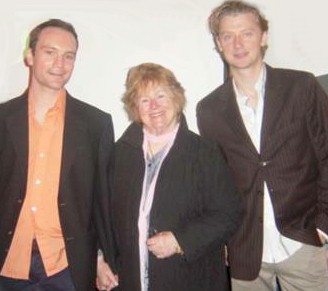 Director Nancy Malone, makes her New York theater
Director Nancy Malone, makes her New York theater
directorial debut with Howie, the Rookie, starring Mark
Byrne and John O'Callaghan._________________________________________
O'Rowe, a sort of Lost Generation Martin McDonagh, is best known here for his screenplay of Intermission, the 2003 film starring Colin Farrell, Colm Meaney and 2004 Tony Award winner [and 2005 Drama Desk and Tony-nominee] Br"an F. O'Byrne.Sounds like a strange project to be directed by a woman and one with such soft-spoken charm, sparkling eyes and genuine warmth. She comes over more as a sprite or, as would better have it, a leprechaun instead of a former Broadway star and Hollywood producer, director and mover and shaker.
She began acting in her early teens. For their 10th Anniversary issue, Life magazine featured her on the cover as "The Typical American Child." She studied acting at the Stella Adler Conservatory, continuing with her until Adler's death, and became a member of the Actors Studio.
Malone acted in television's first soap opera, The First Hundred Years, which led her to audition at age 16, for Broadway. Critics raved when she made her debut in the title role in one of the 1952 season's biggest comedy hits, Time Out for Ginger, opposite Melyvn Douglas and the veteran actress Polly Rowles**.
She went on to star in ground-breaking TV series The Naked City, which earned her her first Emmy nomination, and as the sultry Clara Varner in the TV series adapated from Faulkner's The Long, Hot Summer [opposite Roy Thinnes].
___________________________________________________________
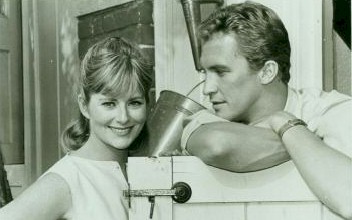
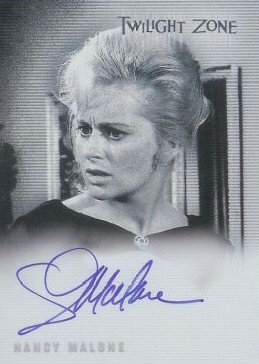
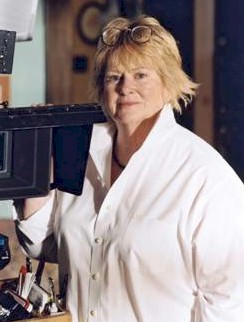 NANCY MALONE in ABC series The Long, Hot Summer, co-starring Roy Thinnes,in The Twilight Zone and, after a career transition, as a TV and film director._________________________________________
NANCY MALONE in ABC series The Long, Hot Summer, co-starring Roy Thinnes,in The Twilight Zone and, after a career transition, as a TV and film director._________________________________________
Leaping forward a couple of decades, she went on to break down barriers for women in TV as a director of such top-rated TV fare as Cagney & Lacey, Beverly Hills 90210, Dawson's Creek, Sisters [Emmy nomination], Judging Amy, Knot's Landing, Melrose Place, Star Trek: Voyager, Touched by An Angel and The Trials of Rosie O'Neill [Emmy nomination].Still going, going, going, with energy to burn, as she approaches 70, Malone looks back on a fascinating career. "They tell me I was a trailblazer," she smiles, "because I was one of the first to do things that women weren't doing. I never thought of myself as anything other than a working person. In retrospect, I realize I did blaze a few trails and the happiest part is that the doors I opened helped a lot of women who came behind me."
In what she makes seem like an effortless segue from acting, in the 60s and 70s she began producing for TV in a male-dominated field. "And it still is," Malone points out. "There was RenÈe Valente, who began producing in the late 50s [movies of the week, mini-series], Carolyn Raskin, who worked on Sinatra specials and produced for Rowan and Martin's Laugh-In and Dinah Shore, and the late Jacquelyn Babbin, out of New York, who really was a pioneer [producing everything from Armstrong Circle Theatre in the early 50s to event programming and daytime dramas (All My Children, Loving) into the 80s], but I don't think there were too many other women."
And, no, the men didn't make it tough. "In fact," relates Malone, "just the opposite. They were wonderful to me. One particular man, Bob Papazian, was executive producer on my first movie, Winner Take All [1975 for TV, starring Shirley Jones, Laurence Luckinbill, Joan Blondell, Sylvia Sidney and Joyce Van Patten]. He was amazingly generous and caring. He gave me confidence. It was a whole new discipline and he walked me through it without making me feel like the newcomer that I was."
Malone's two series starring roles were for ABC and she became friends with network president Tom Moore. "When he was in L.A. on business we had dinner," she recalls, "and he asked me how it was going and I told him I was doing a lot of episodic television [Run For Your Life, Bonanza, among many others]. I said I was disappointed because the women really didn't get to do anything but react to what the guys were doing and that I wanted to be the person who does things. He replied, ëWhy don't you produce?' and I said, ëI'm an actress. What do I know?'"
In the early 70s, Moore was starting a production company, Tomorrow Entertainment, and he brought Malone aboard at $250 a week. "That wasn't big money at all," laughs Malone, "certainly not the money I'd been making. I thought about it long and hard. I knew that if I did that, I'd be closing the door on acting. However, Tom was giving me the opportunity to learn. I had a tiny office with no windows where I read scripts and got acquainted with agents. It wasn't too long before I thought, ëI can do this. My taste is good.'"
Soon, she was bringing projects into the company. Eventually, she became Tomorrow's director of motion pictures.
Malone was a co-founder of Women In Film, which has become the most powerful women's organization in Hollywood. She serves on the Board of Directors and works as the liaison to the Advisory Council on the Women In Film Foundation Board of Trustees.
In 1977, Nancy became the first woman vice president of 20th Century Fox television. With Lucille Ball and Eleanor Perry, she was honored with Women in Film's first Crystal Award. Among the many milestones in her career she is particularly pleased that in 1987, she and Linda Hope co-produced There Were Times, Dear [PBS], the first film about Alzheimer's Disease, which has since helped to raise over $2-million for caregivers throughout the country.
Malone became a director on a fluke and a dare. Working at CBS, they wanted her to use a director she'd known as an actress and wasn't particularly cared for. "They wanted to finish out his contract. I said, ëPlease, no! He's not right for this,' butÖ And, lo and behold, everything I said came true. Not only wasn't he right, but he also made our star unhappy. I said, ëI can do this,' but I wasn't able to take over because I didn't have a Director's Guild card. That was it and I decided I had to get one."
Malone took a year off and entered the directing workshop for women at the American Film Institute. "It's the only program like that in the country and is still kept alive against great odds by Jean Firstenberg."
When she started taking her workshop film on rounds, she met some stumbling blocks. "Studio executives wanted to know, ëWhat are you now? An actress, a producer, a director or what?' Make up your mind! And I said, I was a director."
Finally, six months later, she got an agent and met Esther Shapiro, "who hired me to do the hundredth episode of Dynasty. I said, ëCould you make it a little less pressured!'It was going to be the big deal of the season, but I did it. It was not only successful, the ratings soared through the roof. And Esther said, ëYou're on!'"
One of the pressures of being a director is getting the job done quickly. "There's a big difference between film and TV. In film, you can go about your job a lot more relaxed, but in TV you have a short time to get the results in the can. We have twelve-hour days and, usually, you can get seven to ten pages done. So you don't take lunch and you don't waste time."
Malone loves returning "home" because, every now and then, "I have to have an infusion of New York in my soul. I can't live without out."
She's often been here producing and directing for TV, but had never done a theater piece. When her friend, producer Georganne Heller, approached her about Howie, the Rookie, who thought her experience teaching acting would be very helpful. "My approach to the play has been completely different," she explains. "The layers in the text are very complicated, so that was the first thing I dealt with. Then I worked with Mark and John on the performance aspect to get to the motivation of what makes these boys tick."
For tickets to Howie, the Rookie, call (212) 868-4444 or visit http://www.smarttix.com/.
_______
* 2000 Irish Times New Play Award, 1999 Rooney Award for Irish Literature and, among others, the 1999 Edinburgh Festival Fringe Best Production award. It had acclaimed runs in London, Dublin, Los Angeles and a brief Off Off Broadway run at P.S. 122.** Largely forgotten, Rowles had roles in some of the biggest hits of the 50s, 60s and 70s, including [the original Vera Charles] in Auntie Mame, No Strings, [Madame Xenia in] The Killing of Sister George and Forty Carats, featured with Julie Harris.
___________________________________________________
HIGHLIGHTS from the resume of NANCY MALONE:Other Broadway:
A Touch of the Poet, replacing Kim Stanley in 1959 [big shoes to fill, to say the least]; Major Barbara, October 30, 1956 - May 18, 1957 opposite Glynis Johns as Barbara, Charles Laughton as Undershaft, Burgess Meredith as Adolphus, Eli Wallach as Bill Walker and none other than Cornelia Otis Skinner as Lady UndershaftOther stage roles:
The Seven Year Itch [regional], The Chalk Garden [tour], Requiem for a Heavyweight, The Trial of the Catonsville Nine [Broadway, Los Angeles]Early guest star appearances on:
Alcoa Theatre, Armstrong Circle Theatre, Camera Three [Henry James' Daisy Miller], Hallmark Hall of Fame, Omnibus, Robert Montgomery Presents, Studio One, Twilight Zone, U.S. Steel Hour, Cannon, Danger, Dr. Kildare, 77 Sunset Strip, The Outer Limits, The Fugitive, Big Valley, Bonanza, The Partridge Family, Dr. Kildare, I Remember Mama, Owen Marshall, Suspense and The Rockford FilesProducer, Series TV:
The Bionic Woman; Husband, Wives, Lovers; Bob Hope, the First 90 Years [Emmy Award]Director, Theater:
Big Maggie, Beverly Hills Playhouse [Tyne Daly]; Agnes of God and Prelude To a Kiss, both L.A. TheaterWorks
...< < < < < n JUST RELEASED n < < < < <THE PHANTOM OF THE OPERA FILM ADAPTATION ARRIVES ON DVDIN TWO-DISC WIDESCREEN EDITION WITH FEATURES GALORE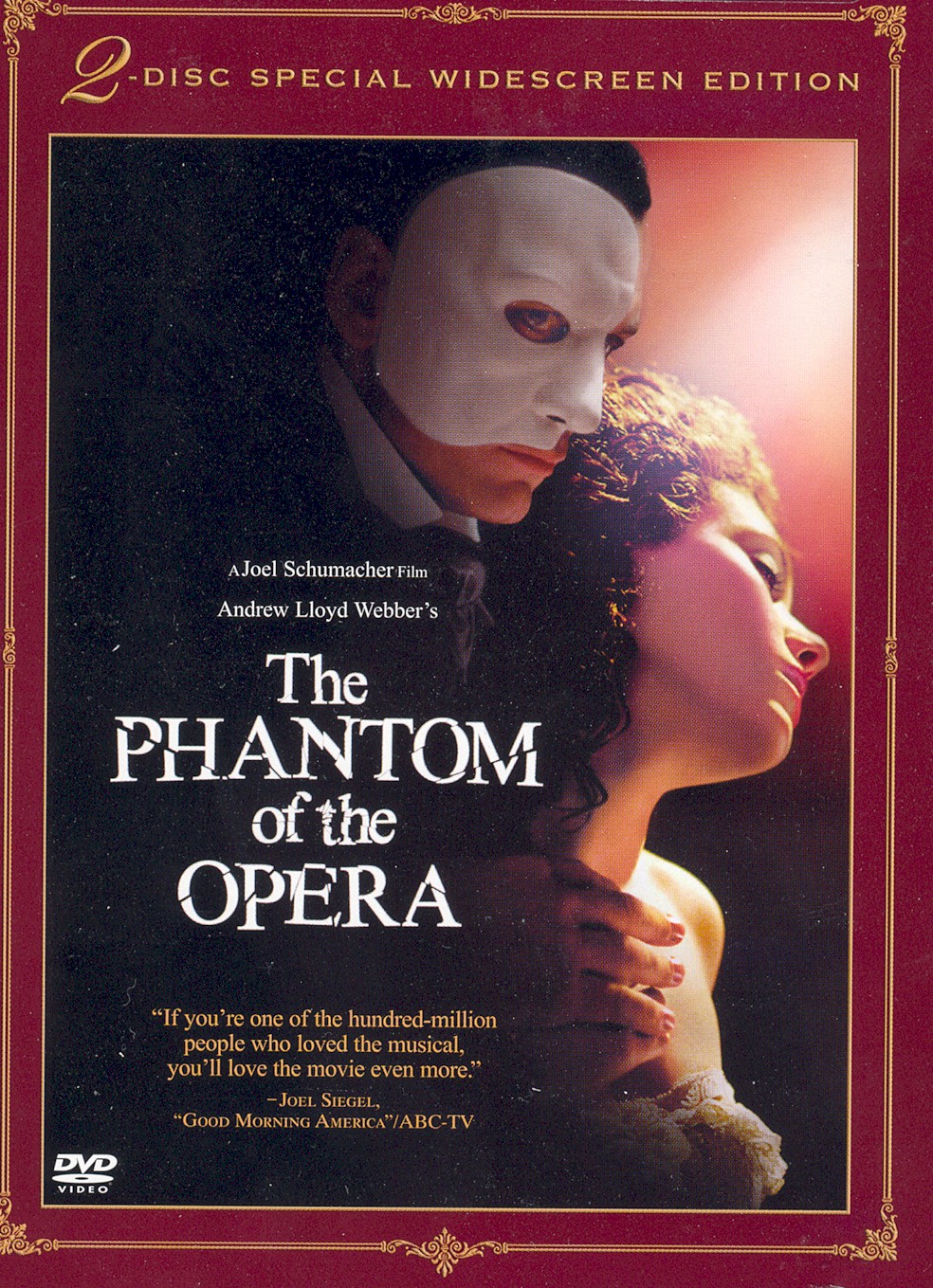
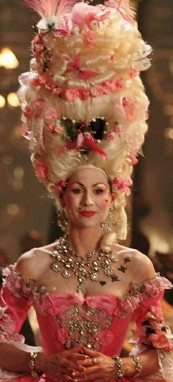
THE DVD RELEASE OF THE PHANTOM OF THE OPERA, starring Gerard Butler,
Emmy Rossum as Christine and, right, Minnie Driver as Carlotta.
Director Joel Schumacher on the London set preparing to shoot "Masquerade."
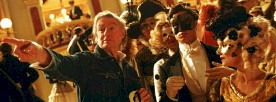
by ELLIS NASSOUR
Do you sing along with the Andrew Lloyd Webber/Charles Hart tunes from the Olivier and Tony Award-winning The Phantom of the Opera? If you haven't yet, you may when you get the new Warner Home Video two-disc DVD of the movie adaptation of the West End, Broadway and world-wide hit musical. The Christmas 2004 release, directed by Joel Schumacher and starring Gerard Butler, Emmy Rossum, Patrick Wilson, Miranda Richardson and, as Carlotta, massive scene-stealer Minnie Driver, arrives for home screening in three formats: VHS, single disc DVD [SRP, $$28] and, the definite choice to purchase, two-disc DVD [[$30].
The extra two dollars buys you a lot of special features, including Behind the Mask, the story of The POTO; an extremely entertaining behind-the-scenes feature, The Making of The Phantom of the Opera in 3 Spellbinding Acts; a deleted scene from the film, featuring the previously unheard "No One Would Listen"; and a "hidden" sing-a-long number.
The Dolby Digital sound is spectacular, especially in those numbers where long-time ALW orchestrator David Cullen and music supervisor Simon Lee increased orchestra size from 28-pieces to 105.
Certainly, other than Minnie Driver's absolutely hilarious and endearing performance, two of the other stars of the film are costumer Alexandra Byrne and production designer Anthony Pratt. Byrne did heroic work, especially with the over-the-top haute couture for diva La Carlotta. Pratt brilliantly took the late Maria Bjornsson's stage designs to a new degree of opulence as befits a sweeping gothic romance [in that vein, as Raoul, you also have Wilson's Fabio-look, even down to the flowing locks].
Actual locations were not good enough for Schumacher, so Pratt built sets, including an 886-seat opera Opera Populaire, loosely based on the Paris' Opera Garnier, in sections on eight stages of London's Pinewood Studios. Pratt noted he endeavored to establish a macabre quality in every set. You'll notice that especially on the sensuous gold-hued figures with lyres that entwine, as they do in the stage production, the proscenium. A spectacular detail of the auditorium design is the chandelier [that we all know will come crashing down], outfitted with 20,000 Swarovski crystal pendants.
Cinematographer John Mathieson [Gladiator]'s sequences of tracking shots upstairs, downstairs and throughout the backstage and opera house auditorium are quite stunning. These sets were built in a studio service road, allowing Mathieson to move his camera seamlessly between action onstage, in the fly spaces and in the bustling workshops.
[Photos: ALEX BAILEY/Warner Bros.]
--------Ellis Nassour is an international media journalist, and author of Honky Tonk Angel: The Intimate Story of Patsy Cline, which he has adapted into a musical for the stage. Visit www.patsyclinehta.com.
He can be reached at [email protected]
Why are you looking all the way down here?
For more articles by Ellis Nassour, click the links below!
Previous: STEPHEN SCHWARTZ'S CAPTAIN LOUIE FLIES; LANDS AT THE YORK
Next: HARVEY FIERSTEIN returns as host of the Drama Desk Awards
Or go to the Archives
[Broadway Ad Network]
[Broadway Ad Network]

If you would like to contact us, you can email us at feedback@
broadwaystars.com
[Broadway Ad Network]
[Broadway Ad Network]

- July 15: Harry Connick, Jr. in Concert on Broadway - Neil Simon
- Sept. 28: Brief Encounter - Studio 54
- Sept. 30: The Pitmen Painters - Samuel J. Friedman Theatre
- Oct. 3: Mrs. Warren's Profession - American Airlines Theatre
- Oct. 7: Time Stands Still - Cort Theatre
- Oct. 12: A Life In The Theatre - Schoenfeld Theatre
- Oct. 13: Bloody Bloody Andrew Jackson - Bernard Jacobs Theatre
- Oct. 14: La Bete - The Music Box Theatre
- Oct. 21: Lombardi - Circle In The Square
- Oct. 25: Driving Miss Daisy - John Golden Theatre
- Oct. 26: Rain - A Tribute To The Beatles On Broadway - Neil Simon Theatre
- Oct. 31: The Scottsboro Boys - Lyceum Theatre
- Nov. 4: Women On The Verge Of A Nervous Breakdown - Belasco Theatre
- Nov. 9: Colin Quinn Long Story Short - Helen Hayes Theatre
- Nov. 11: The Pee-Wee Herman Show - Stephen Sondheim Theatre
- Nov. 13: The Merchant of Venice - The Broadhurst Theatre
- Nov. 14: Elf - Al Hirschfeld Theatre
- Nov. 18: A Free Man Of Color - Vivian Beaumont Theater
- Nov. 21: Elling - Ethel Barrymore Theatre
- Dec. 9: Donny & Marie: A Broadway Christmas - Marquis Theater
- Jan. 13: The Importance of Being Earnest - American Airlines Theatre
- Mar. 3: Good People - Samuel J. Friedman Theatre
- Mar. 6: That Championship Season - Bernard B. Jacobs Theatre
- Mar. 11: Kathy Griffin Wants a Tony - Belasco
- Mar. 17: Arcadia - Barrymore Theatre
- Mar. 20: Priscilla Queen Of The Desert The Musical - The Palace Theatre
- Mar. 22: Ghetto Klown - Lyceum Theatre
- Mar. 24: The Book Of Mormon - Eugene O'Neill Theatre
- Mar. 27: How To Succeed In Business Without Really Trying - Al Hirschfeld Theatre
- Mar. 31: Bengal Tiger at the Baghdad Zoo - Richard Rodgers Theatre
- Apr. 7: Anything Goes - Stephen Sondheim Theatre
- Apr. 10: Catch Me If You Can - The Neil Simon Theatre
- Apr. 11: The Motherf**ker with the Hat - Gerald Schoenfeld Theatre
- Apr. 14: War Horse - Vivian Beaumont Theater
- Apr. 17: Wonderland: A New Alice. A New Musical Adventure. - Marquis Theatre
- Apr. 19: High - Booth Theatre
- Apr. 20: Sister Act - The Broadway Theatre
- Apr. 21: Jerusalem - Music Box
- Apr. 24: Born Yesterday - Cort Theatre
- Apr. 25: The House of Blue Leaves - Walter Kerr Theatre
- Apr. 26: Fat Pig - Belasco Theatre
- Apr. 27: Baby It's You! - Broadhurst Theatre
- Apr. 27: The Normal Heart - Golden Theater
- Apr. 28: The People in the Picture - Studio 54
- Apr. 28: The End of The Season
- Jun. 12: The 65th Annual Tony Awards - Beacon Theatre
- June 14: Spider-Man, Turn Off The Dark - Foxwoods Theater
- June 21: Master Class - Samuel J. Friedman

